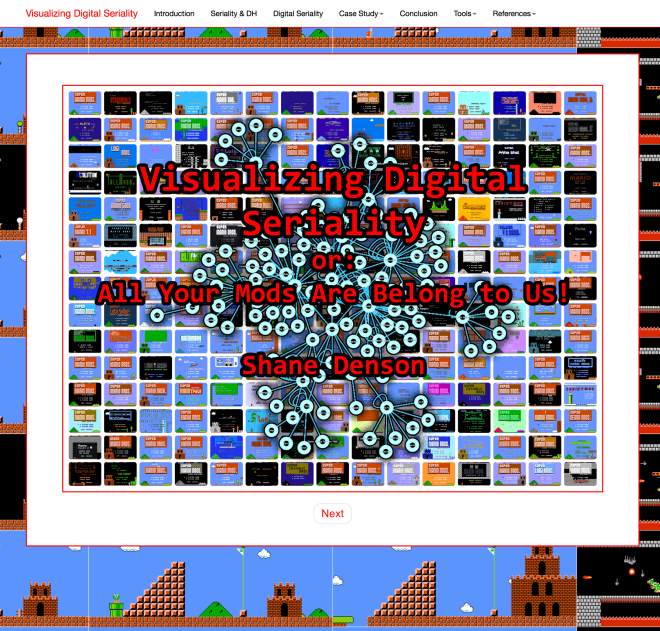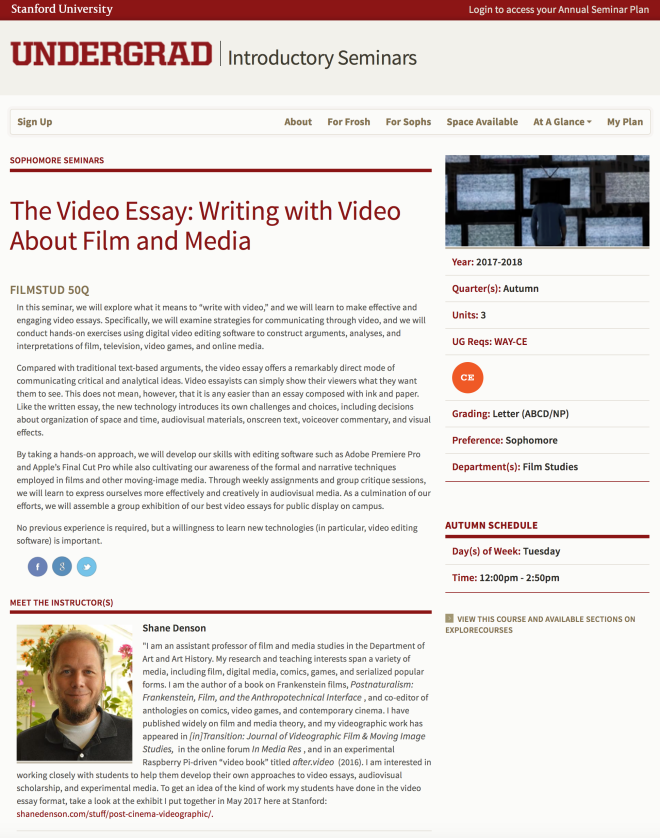I am excited to see my interactive piece, “Visualizing Digital Seriality, or: All Your Mods Are Belong to Us,” out now in the latest issue of Kairos: A Journal of Rhetoric, Technology, and Pedagogy. This is by far the most technically demanding piece of scholarship I have ever produced, and it underwent what is possibly the most rigorous peer-review process to which any of my published articles has ever been subject. If you’re interested in data visualization, distant reading techniques, network graphing, critical code studies, game studies, modding scenes, or Super Mario Bros. (and who doesn’t like Super Mario Bros.?), check it out!
Author: shanedenson
The Meaning of “Animation” in Edison’s Frankenstein (1910)
This video is an experimental “annotation essay” that develops a reading of Edison’s Frankenstein (1910) through on-screen text annotations. This is the complete film, unedited except for the annotations and new digital intertitles.
The video’s argument is adapted from Chapter 3 of my book Postnaturalism: Frankenstein, Film, and the Anthropotechnical Interface: “Monsters in Transit: Edison’s Frankenstein.”
This is my second Frankenstein-themed video essay. The first one, on sound in James Whale’s Frankenstein (1931), can be found in the online journal [in]Transition.
What is Monster? What is Human?
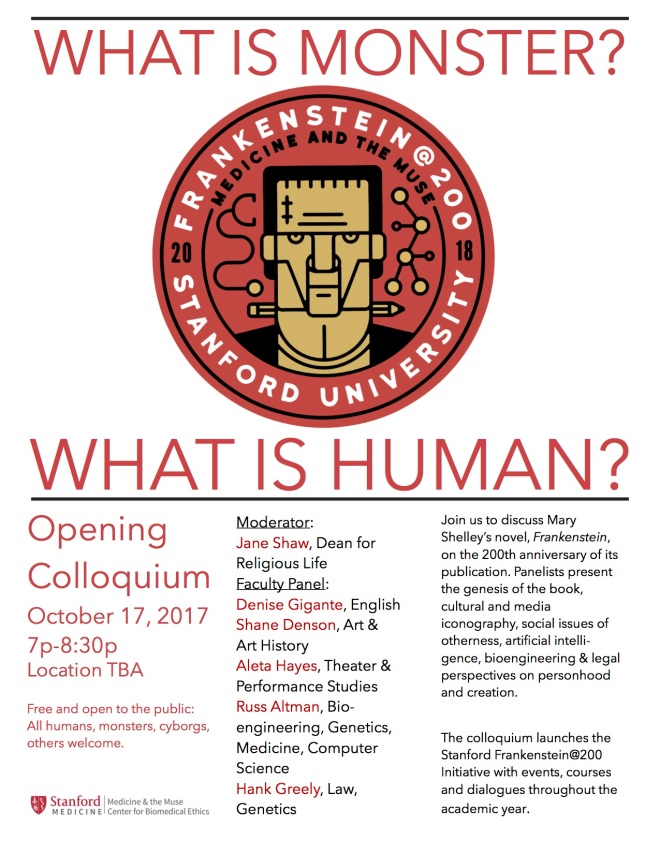
Poster for the opening colloquium for Stanford’s Frankenstein@200 Initiative, October 17, 2017. I’ll be speaking alongside Denise Gigante, Aleta Hayes, Russ Altman, and Hank Greely, moderated by Jane Shaw. Location TBA.
Free and open to the public: All humans, monsters, cyborgs, others welcome.
The Video Essay: Writing with Video About Film and Media
This fall, I am excited to teach a new course, “The Video Essay: Writing with Video About Film and Media,” as a part of Stanford’s Introductory Seminars program. Geared towards sophomores from any major, this small class will combine practical instruction in video editing, analysis and discussion of exemplary video essays, hands-on lab sessions, and group critique of student work.
The course draws essential inspiration from the NEH-funded “Scholarship in Sound & Image” workshop, organized by Christian Keathley and Jason Mittell at Middlebury College, which I participated in back in 2015.
More info about the course can be found on Stanford’s Introductory Seminars website.
Post-Cinema: Videographic Explorations (select video essays now online)

A selection of video essays from the exhibition Post-Cinema: Videographic Explorations, which ran May 1-12, 2017 at Stanford University, is now available for viewing online.
The video essays, by leading filmmaker-scholars Kevin B. Lee and Allison de Fren as well as students in my “Post-Cinema” seminar (winter 2017), deal with a variety of contemporary media forms and phenomena – including digital animation, Beyoncé’s Lemonade and the visual album, contemporary horror, slow cinema, post-cinematic television and transmedia franchises, among others.
You can find the video essays on my website, under “Videographic Scholarship” on the catch-all “STUFF®” page (where you’ll also find a variety of digital and creative projects). Or go straight to the exhibition page.
All About Seriality: Henry Jenkins’s 4-Part Interview with Frank Kelleter
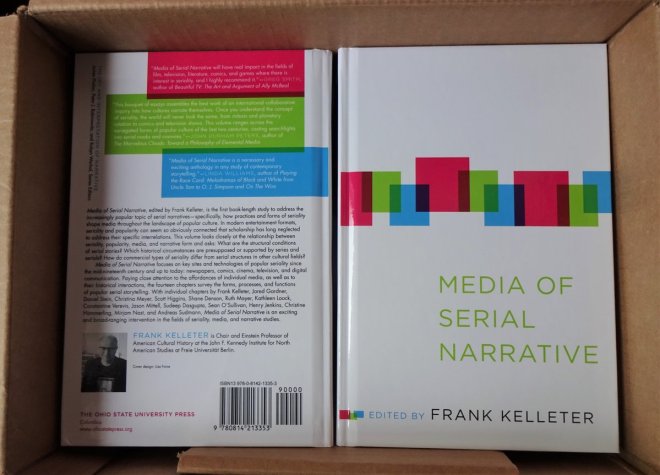
Following the recent publication of Media of Serial Narrative, edited by Frank Kelleter, there is a 4-part interview with Kelleter conducted by Henry Jenkins over on the latter’s blog. The interview is far-ranging and offers a good introduction to the volume and to the broader work conducted by the Popular Seriality Research Unit from 2010 to 2016, continued in ongoing work today.
Post-Cinema — Video Essay Exhibition Opens Today
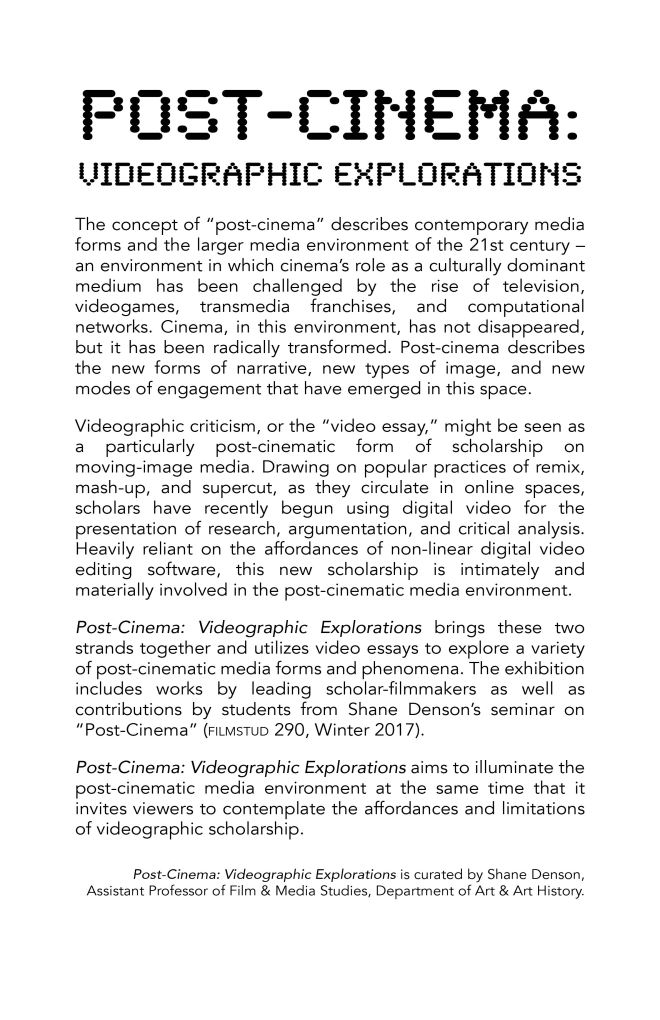
Post-Cinema: Videographic Explorations — an exhibition of video essays that I am curating at Stanford — opens today. The wall text (above) outlines the aims and objectives of the show. Here is a list of the 13 works included:
Post-Cinema: Theorizing 21st-Century Film (Book Trailer), 2016
Shane Denson
Video, 4:12The Beyoncé Image: Synesthetic Abilities of the Visual Album, 2017
Cleo Chung
Video, 17:07Iñárritu’s Films in a Conversation on Realism, Hyperrealism, Time-Image, and Movement-Image, 2017
Raquel Orendain Shrestha
Video, 4:00WTF IS THAT? The Pre- and Post-Cinematic Tendencies of PARANORMAL ACTIVITY, 2017
Allison de Fren and Brian Cantrell
Video, 10:12hijab.key, 2016
Shane Denson
Video, 2:46The Shared Universe Cinema, 2017
Will Ferrer
Video, 21:18Transformers: The Premake (a desktop documentary), 2014
Kevin B. Lee
Video, 25:03Slowness and Slow Cinema, 2017
Spencer Slovic
Video, 11:42FX’s LEGION and Post-Cinematic Television, 2017
Katie Adams
Video, 19:31Questioning the Human Machine in EX MACHINA, 2016
Allison de Fren
Video, 10:26New Forms of Racism in the Post-Cinematic Dispositif, 2017
Jace Alexander Casey
Video, 4:02A Closer Look at/into Depth Perception: Illusion, Impression, and Indexicality in Animation, 2017
Ouree Lee
Video, 20:14VHS Found Footage and the Material Horrors of Post-Cinema, 2015
Shane Denson
Video, 5:02
Cine-Serialities

On Tuesday, May 9, 2017, Kathleen Loock (Freie Universität Berlin/University of Wisconsin-Madison) will be holding a guest lecture on “Cine-Serialities: The Industrial Logics, Aesthetic Pleasures, and Discursive Constructions of Cinema’s Serial Forms.” The lecture will take place at 1:30pm in the McMurtry Building, room 350.
Out Now: Media of Serial Narrative

Media of Serial Narrative, edited by Frank Kelleter and published by The Ohio State University Press, is out now! The book includes 14 chapters, two of which I co-authored: “Spectral Seriality: The Sights and Sounds of Count Dracula” (co-authored with Ruth Mayer) and “Digital Seriality: On the Serial Aesthetics and Practice of Digital Games” (co-authored with Andreas Sudmann). Here’s the full table of contents:
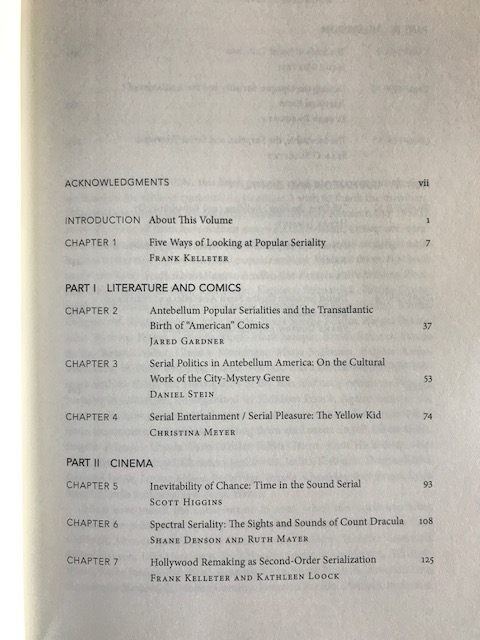
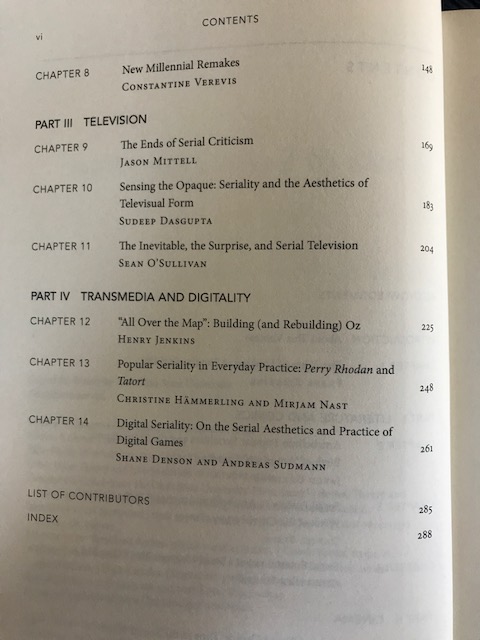
Post-Cinema: Videographic Explorations
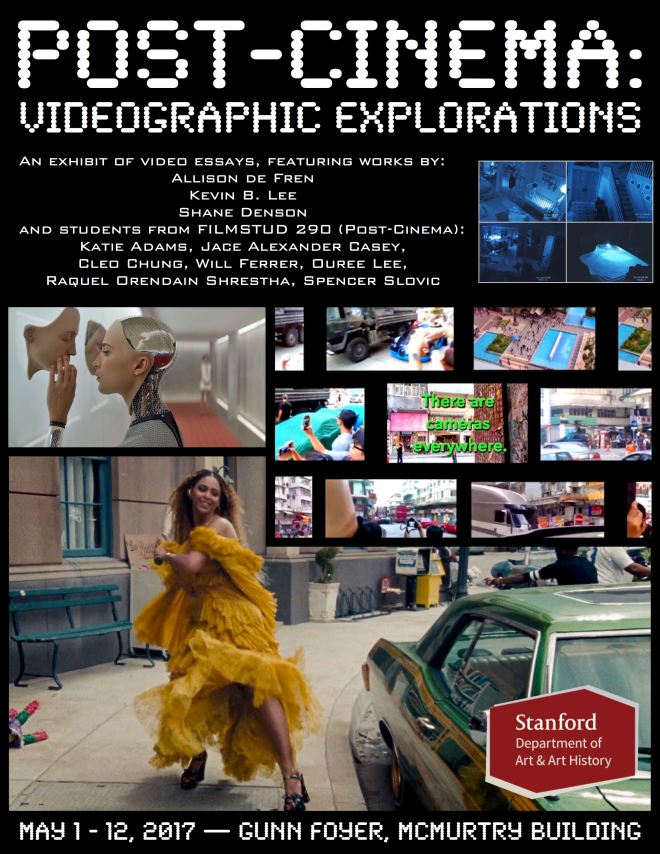
Starting May 1, I am proud to present an exhibition of video essays, including works by well-known scholar-filmmakers Allison de Fren and Kevin B. Lee, as well as students from my “Post-Cinema” seminar. Selected videos deal with a range of topics, including digital animation, Beyoncé’s Lemonade and the visual album, contemporary horror, slow cinema, transmedia franchises and post-cinematic television, and more.
The show will be on view May 1-12, 2017 in the Gunn Foyer, McMurtry Building (home of the Department of Art & Art History) at Stanford University.
